In this video I will play three examples and explain how to use the, in earlier videos explained, pentatonic groups over a blues.
Tag Archives: beginner
Blues basics 4 – pentatonics and approach notes
I have divided the pentatonic scale into small groups around the roots of the blues chords. These groups i will use to approach the roots in the blues, its simpler than it sounds 🙂
I have devided the pentatonic scale into groups.

the groups are associated with the roots of the chords in the blues. The D, G and A.

Ill apply the groups and use them to target the root of the next bar.
in the following example i play the root of the chord on beat one. In the bar before I approach the one with the group belonging to the coming root.
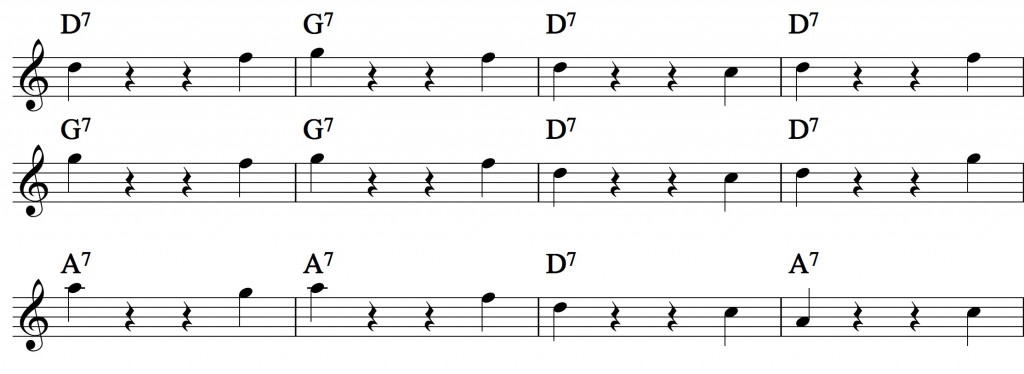
You can see that the root is on the one of each bar and leading to the root I use the notes in the group of the coming root. Leading towards bars with the root D I use F and C as approach notes, leading to a G bar i use A and F and leading to an A bar i use the approach notes C and G. All connected through the groups beloning to the root.
You see in the above example that I in the first bar leading to the second bar, on the four, apply F leading to the G of the second bar. Bar two to three i connect with the approach note C in the group of D. On the ninth bar i apply the G leading to the A. The rule would be that i look in the coming bar for the root and backwards i apply the group beloning to the coming bar.
In the next example i only use the approach note from above. The notes would be F to D, A to G and C to A.
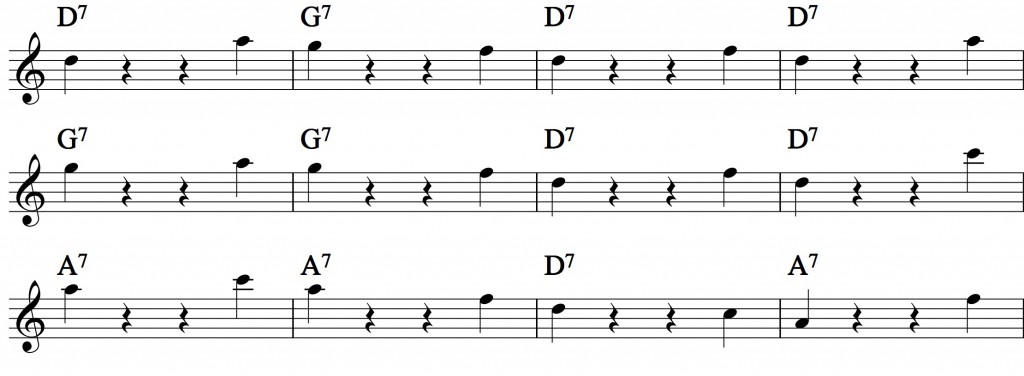
Its clear that the notes are upper approach note in the groups.
This exercise is only applying the notes below the root.
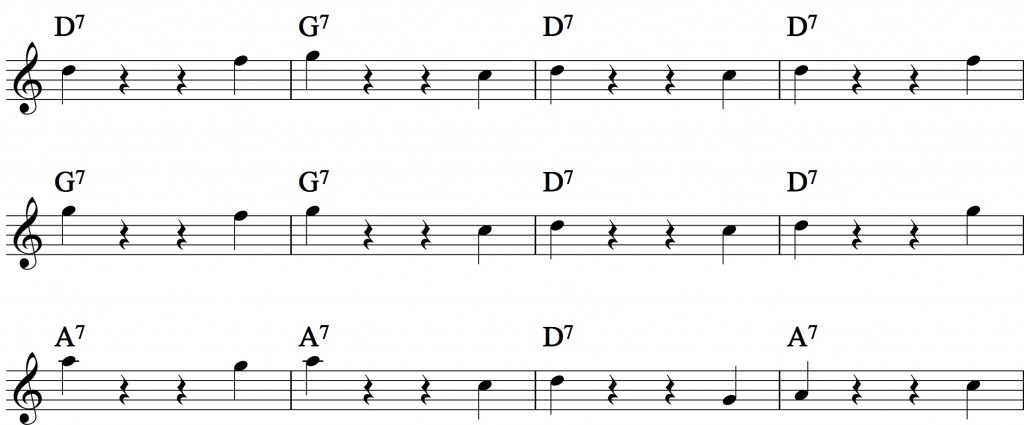
C to D, F to G and G to A. Playing towards the target note which in this case is the root.
This way of practising playing towards a target note is quite simple and easy to get used to.
When soloing in jazz music its common practise that you always play towards a target note to get a clear melodic line.
I go on to the next exercise where i change the approach notes. I dont play only one direction anymore but pick the approach note freely, above or below.
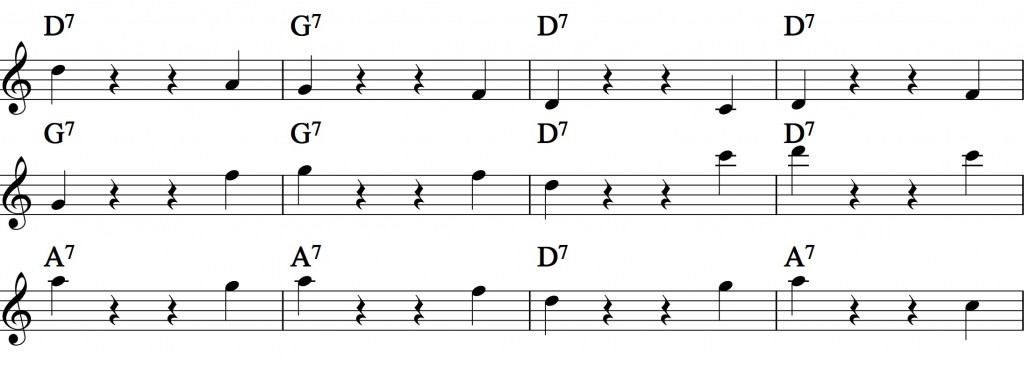
The most important to understand in this lesson to do this a lot, to get this way of playing into your ears and fingers.
in the coming exercise i play the approach note as an eight note so, keeping the same rhythm in the whole exercise but changing which approach note i use, above or below.
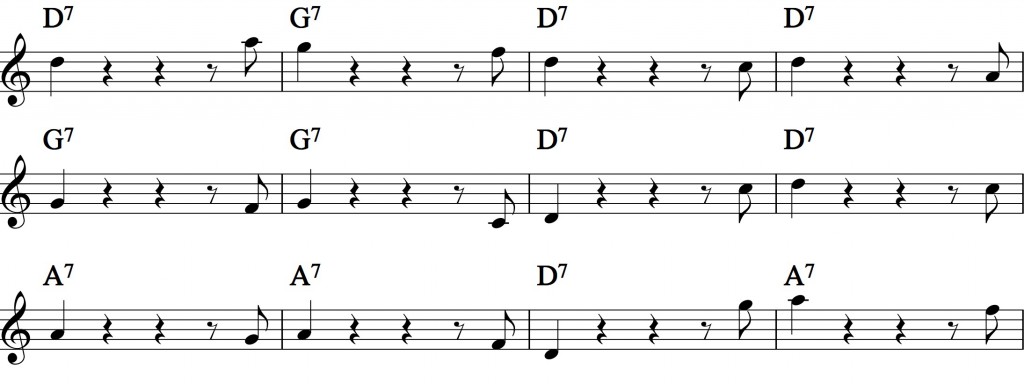
You can always add more rhythm which the next exercise will illustrate.
Playing two eight notes approach and melodically choosing the above or the below lying note.
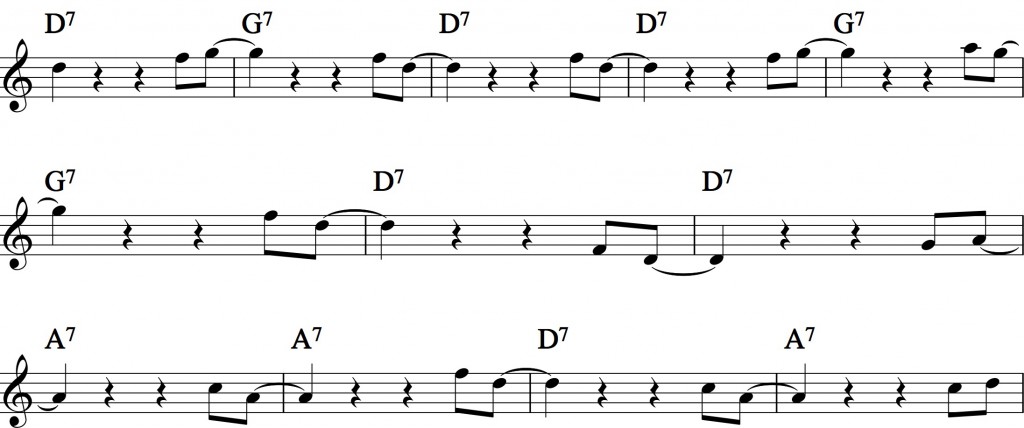
The more notes and rhythm you add before the target note the more complicated it gets of course.
In my next video ill get into more more examples where i use more approach notes.
Let me know if you have questions about this.
I hope that these videos inspires you as much as they inspire me.
Enjoy and have fun playing 🙂
If you want to stay up-to-date with my videos:
subscribe to my newsletter (top left of my website)
subscribe to my youtube-channel.
You can also find me on twitter, instagram, facebook and google+ as sorenballegaard
Blues basics 3 – applying the pentatonic scale chord groups in blues examples
Still playing the (basic) blues!
In this video lesson i give examples in how to apply the, in earlier videos, mentioned groups in a blues solo.
I have made some examples of how you can play the blues using the pentatonic scale divided into groups around the roots of the chords of a basic blues.
Example one – played two times
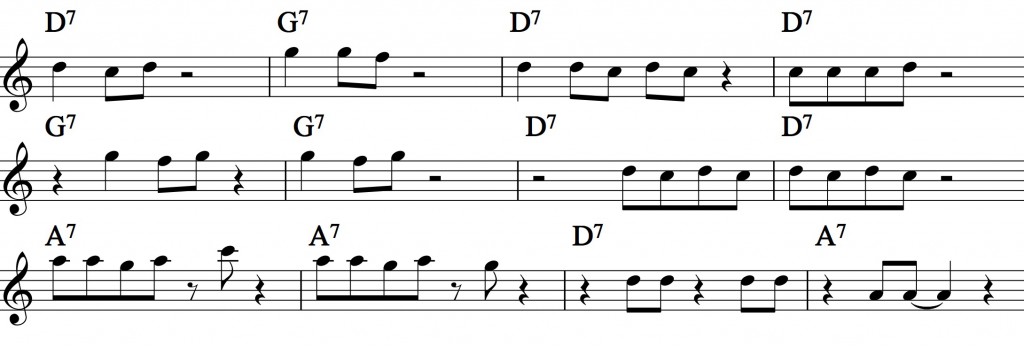
In these examples i stay inside the groups and in most bars I start the line on the root note.
I start the first bar with the D group – root D one below C and then again the D, second bar i play the root G twice and the note below, the F. third bar – D and switch between the root and the note below C. ending the first four bars with not beginning on the root but answering to the third bar with starting on the note below C thrice and ending on the D.
Fifth bar I do not start on the first beat but on the second beat G F G, the pattern from the very first bar, continuing on the sixth bar repeating the pattern from the fifth bar, but placed on the first beat, as an answer to the fifth bar. The seventh and eights bar I build together in a continuing string of notes D C D C D C D C, getting into the feel of playing longer eight note lines. In the ninth and tenth bar i repeat a pattern in the A group – A A G A but add a tail ending in bar nine on a C and bar ten on a G leading the way towards bar eleven, a rhtymical pattern on the two and four – kind of bass pedal like on the root D and bar twelve A.
Example two:
The lines in this bar is more in continuation of each other, which means that the lines grow longer and are not individually placed but mostly answers or follow up on the previous line.
I also slowly move away from always beginning on the root. Fx. i can start the D group on F or C also, a line on the G group can be started on the F or the A, and in the A group i can start on the G or the C for example.
important to know is that you can start a line on these other notes but due to our limited material the starting note fx the F on a D does not mean that the F really sounds like D. Consider it more a leading tone towards D. The D is still nessesary to make the D bar sound like D.
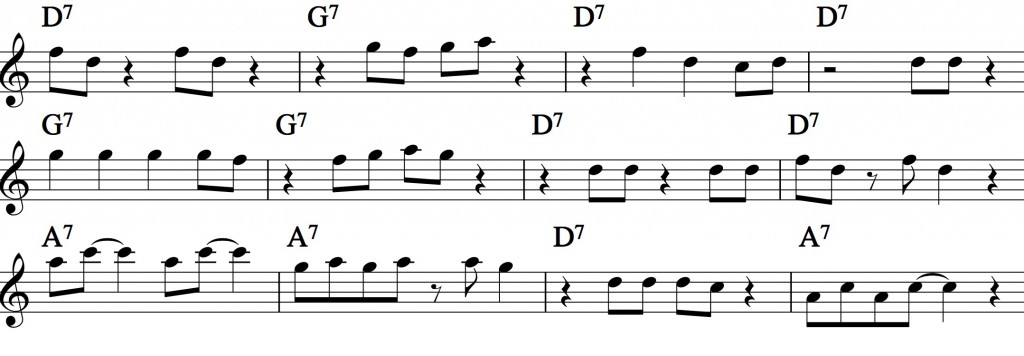
I begin with a rhytmical pattern on the one and three F D – F D on the second bar i start on the two of the bar playing all the notes of the G group, G F G A, the third bar play as quarter notes F D and end with eight notes C D. The fourth bar where i place two D´s as eight notes on the three sounds like an upbeat for the fifth bar where i continue with the quarternote pattern G G G – eightnotes G F – which i answer on the sixth bar on the second beat F G A G. In the seventh and eight bar i play a line in the group of D which definitely goes over the barline – On two and four i play D D which leads on to the second bar of D – F D and moved rhythmically F D. On the ninth bar i play a standard blues lick A C A C, kind of a shout which gets its answer on the tenth bar G A G A and ending with another answer A G, leading towards lower lines on the elleventh bar D D D C, going even lower ending on the twelvth bar with the shouth from bar ten A C A C as eight notes.
example three:
I now fully play eight note lines, in the bar but also extending the lines over the barlines, which is one of the goals with these exercises. Further i also change from only stating on the regular beats to also start a line on the off beats which gives the lines a more jazzy feeling.
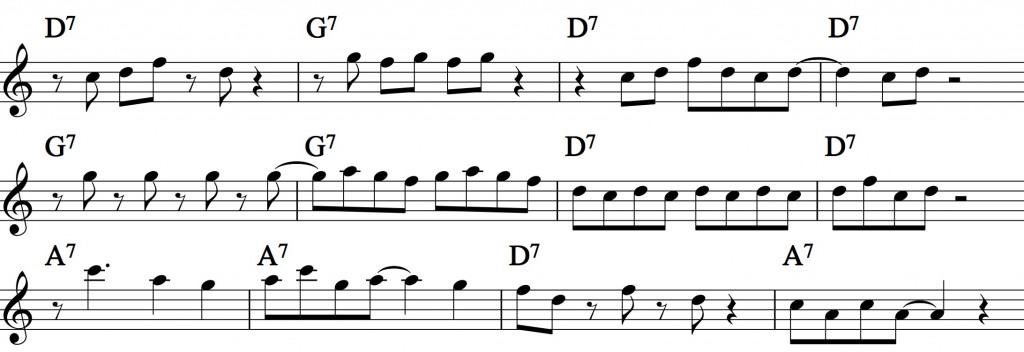
Bar one, i start on the lower note of the D group playing around the Root, C D F D leading towards bar two answering with the G group G F G F G, ending the sentence on bar three and four with a long eight note line over the barline playing around the D – C D F D C D—over the barline to bar four C D. Start a new sentence over the next four bars|G|G|D|D|in bar five, playing the G as off beats in bar five, continuing over the barline to bar six with playing around the G A G F G A G F leading down to the D and still continuing the line in eight notes D C D C D C D C ending in bar eight with an answer to it all leading toward the last D – D F C D. In bar nine i jump into a blues line in quarter notes, as an opposite of the eight notes just played before, A group – C A G continuing on bar ten A C G A ending bar ten leading towards bar 11 with a G going to the F D on bar eleven, Repeating the F D changing it rhythmically, ending on bar twelve with C A C A ready to start fresh on a next round 🙂
I really enjoy making these videos and it inspires me to practise my self, i hope it inspires you to do the same!
Enjoy and have fun playing 🙂
If you want to stay up-to-date with my videos:
subscribe to my newsletter (top left of my website)
and/or
subscribe to my youtube-channel.
You can also find me on twitter, instagram and facebook, google+ as sorenballegaard
Blues basics 2 – outlining the chords w/ pentatonic scale
This video is intended for the beginning improviser. I talk about the blues form and how you can easily apply a pentatonic scale and still outline the basic chord progression.
This is the second video in the series.

In the pentatonic scale of D minor, the notes D F G A C D, i find all the notes of the roots of the simple blues form.
on the first degree a D, on the fourth degree the G and on the fifth degree the A.

As you see the first bar is a D, second bar is G third and fourth bar is a D, in the fifth and sixth bar you have G, seventh and eights bar is D, ninth and tenth bad is A, the elleventh bar is D and the twelth bar is A.
I divided the pentatonic scale into three groups, one around each root of the basic blues scheme.

The groups consists of the root + one note from the pentatonic above the root and one note below the root.
The D group is root D + F above and C below, G group is root G + A above and F below, A group is root A + C above and G below.
These notes are all diatonic notes to the D pentatonic scale.
I will now slowly start improvising with these groups over the blues. This means that i actually outline the roots of the chords but still stay within very simpel and understandable material.
To learn the groups well you can play the following exercises.

You should try to learn these exercises by heart to be able to play it when you hear it and not when you see this on paper.
You can play these exercises using a metronome to also practise your timing while leaning these groups.
The is the group of G
set the metronome on fx. two and four. 
The group of A
metronome on 2+4 a bit faster.

Start slowly with the metronome in a slow tempo and get the notes into your ears and fingers.

The groups are defined by the roots of the blues.
The D group is root D + F above and C below, G group is root G + A above and F below, A group is root A + C above and G below.
Sourrounding the roots with the closest by diatonic notes of the D minor pentatonic scale.
Ill play a few more examples so you can see how to get on with this concept and use it yourself in youor solos.
The first example:

This example plays a steady rhythm on all bars and applys root of the group and the note below the root. fx. on D group the D and the C. Play through the form many times till you have this very firmly in your ears and fingers.
In the next exercise i change the rhythm and the note choice.
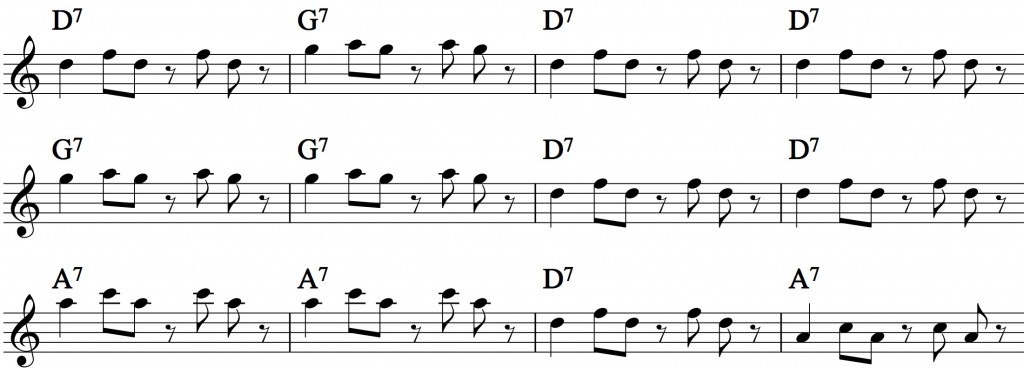
I now play the group root + the note above, fx in the G group i play the G and the Bb.
Try to lear the groups by heart and play as much as you can over the blues with the groups till its firmly planted in your ears and in your fingers.
I wish you very much good luck with this and hope to see you back soon.
Enjoy and have fun playing 🙂
If you want to stay up-to-date with my videos:
subscribe to my newsletter (top left of my website)
and/or
subscribe to my youtube-channel.
You can also find me on twitter, instagram and facebook as sorenballegaard
Blues basics 1 – outlining the chords w/ pentatonic scale
This video is intended for the beginning improviser. I talk about the blues form and how you can easily apply a pentatonic scale and still outline the basic chord progression.
Ill play the D blues and apply the Dminor pentatonic scale to the blues.

The notes are D F G A C D
To get the scale in your fingers and ears and down to the saxophone you should definitely play the scale over the whole range of the horn. 
From low D to the high F and back to the low D
Keep exercising the scale until you master it on the saxohone but als able to hear and recognize it.
The next exercise is playing the pentatonic scale from every step of the pentatonic scale from the D going 7 notes up and back to the D. Continuing from the F and 7 notes up and back. repeating this from every step of the scale.

If you can play it up you can also play it down:

These exercises trains your fingers but also your ears to hear the scale.
To play the blues you also need the form of the blues. I made a very simple blues scheme to practise on.

I use only the first, fourth and the fifht degree of the blues. First degree D7, fourth G7 and fifth degree A7.
The first chord is a D7 chord, then follows a G7, then two times D7.
In the 5th and 6th bar you find two times a G7 chord and there after in the 7th and 8th bar we have again two times D7.
The 9th and 10th bar we have the A7, in the 11th bar we have the D7 and ending in the 12th bar with a A7.
You can practise the form by only using the roots of the chords. Play the roots for four beats each follying the progression of the form

When you have gotten used to the roots of the chords playing them without music you should try applying music, pick a simple playalong track of the blues.

play this a couple of times so you get used to the sound of the music.
You can of course change the ocatve of the root. Try to improvise with what octave you play the root in.
I play the following round written down and there after I improvise two rounds woth playing the roots in different octaves.
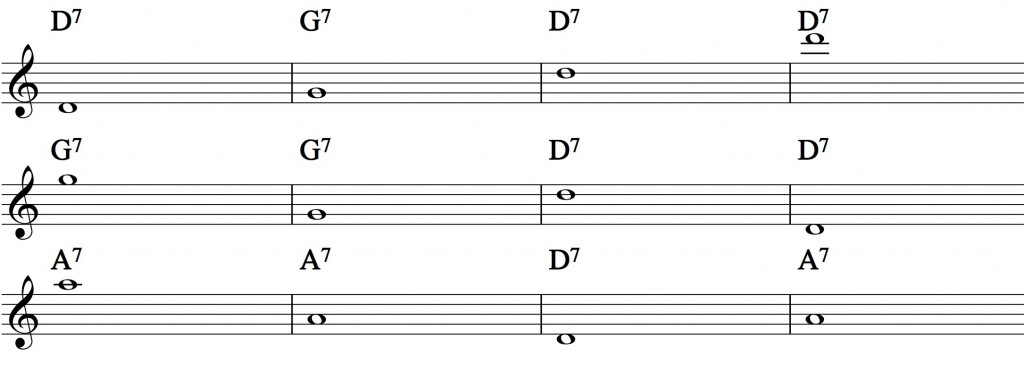
With this exercise i can explore the different sounds of the roots in different octaves and i can learn the how the chords of the blues move. Play these exercises intensly to learn this by heart, when you improvise you do not have time to check papers, the music has to come directly from your ear and be channeled directly to your saxophone.
When this is learned you can start applying different rhythms to the root notes of the blues.
Start change the rhythm and fool around with the different possiblities of rhythm in the bar, still playing only the root.
I made a little exercise of this. I have written out one chorus of blues and thereafter i will continue to improvise for two more choruses.

I continue for two more rounds:

i only use 8th notes in this exercise because i want to have that nice swing feel which is one of the most important factors in jazz. more advanced rhythmic patterns like triplets and 16th notes figures can be applied later. Now its time for the basics of the blues.
Listen to count basis, duke ellington, sammy nestico bigband music to get this feeling.
I hope you can use the notes,
Enjoy and have fun playing 🙂
If you want to stay up-to-date with my videos:
subscribe to my newsletter (top left of my website)
and/or
subscribe to my youtube-channel.
You can also find me on twitter, instagram and facebook as sorenballegaard


